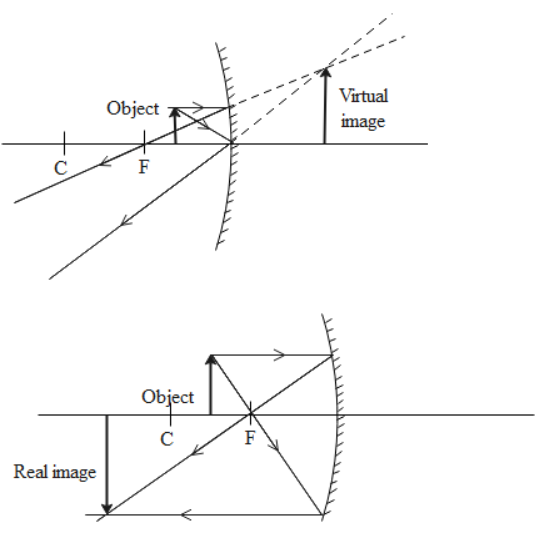
What is the nature of image formed by a concave mirror?
A. Real and inverted
B. Virtual and erect
C. Depends on the position of the object
D. Real and erect
Answer
507.3k+ views
1 likes
Hint: When an object is placed very close to the convex mirror, then we obtain virtual images which cannot be obtained on a screen while if the object is kept away then real images are formed which can be obtained on a screen.
Complete step by step answer:
The two types of spherical mirror commonly used are concave mirror and convex mirror. They are made by polishing the inner or outer side of a curved glass. Convex mirror is made by polishing the outer curved surface while a concave mirror is made by polishing the inner curved surface.
In a concave mirror, due to the nature of the inner reflecting surface, the light rays incident on it tend to converge.
Image formation in concave mirrors depends on the distance of the object from the mirror.
When the object is positioned very close to the mirror, we obtain a virtual and magnified image. At larger distances from the mirror, the images formed are real and inverted.

Therefore, the correct answer should be option C as the nature of image depends on distance of object from the mirror
Note: The laws of reflection are valid at all points on the curved surface of a concave mirror as well as a convex mirror. The light rays converge in a concave mirror because the normal on the surface of the mirror is not the same at all points of the mirror and changes due to the curve of the mirror. Same reasoning is valid in the case of convex mirrors which diverge the incident light rays.
Complete step by step answer:
The two types of spherical mirror commonly used are concave mirror and convex mirror. They are made by polishing the inner or outer side of a curved glass. Convex mirror is made by polishing the outer curved surface while a concave mirror is made by polishing the inner curved surface.
In a concave mirror, due to the nature of the inner reflecting surface, the light rays incident on it tend to converge.
Image formation in concave mirrors depends on the distance of the object from the mirror.
When the object is positioned very close to the mirror, we obtain a virtual and magnified image. At larger distances from the mirror, the images formed are real and inverted.

Therefore, the correct answer should be option C as the nature of image depends on distance of object from the mirror
Note: The laws of reflection are valid at all points on the curved surface of a concave mirror as well as a convex mirror. The light rays converge in a concave mirror because the normal on the surface of the mirror is not the same at all points of the mirror and changes due to the curve of the mirror. Same reasoning is valid in the case of convex mirrors which diverge the incident light rays.
Latest Vedantu courses for you
Grade 9 | CBSE | SCHOOL | English
Vedantu 9 CBSE Pro Course - (2025-26)
School Full course for CBSE students
₹35,000 per year
Recently Updated Pages
Express the following as a fraction and simplify a class 7 maths CBSE

The length and width of a rectangle are in ratio of class 7 maths CBSE

The ratio of the income to the expenditure of a family class 7 maths CBSE

How do you write 025 million in scientific notatio class 7 maths CBSE

How do you convert 295 meters per second to kilometers class 7 maths CBSE

Write the following in Roman numerals 25819 class 7 maths CBSE

Trending doubts
A boat goes 24 km upstream and 28 km downstream in class 10 maths CBSE

The British separated Burma Myanmar from India in 1935 class 10 social science CBSE

The Equation xxx + 2 is Satisfied when x is Equal to Class 10 Maths

What are the public facilities provided by the government? Also explain each facility

Difference between mass and weight class 10 physics CBSE

SI unit of electrical energy is A Joule B Kilowatt class 10 physics CBSE




